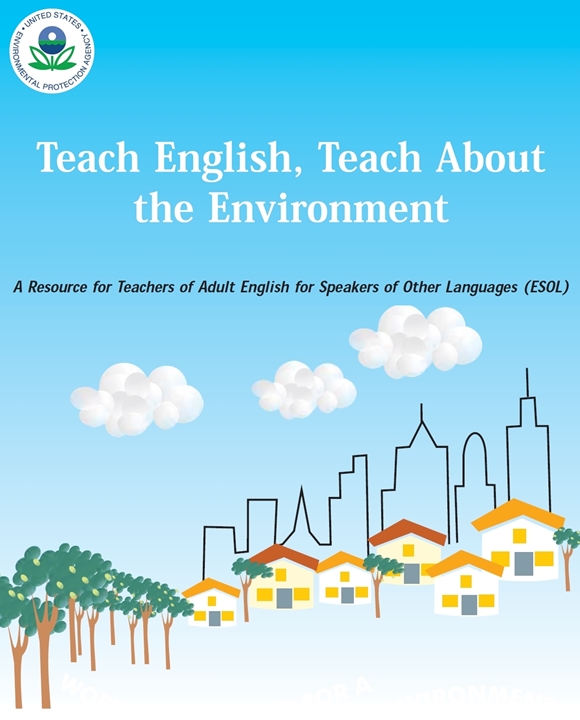Download Teach English, Teach about the Environment, a curriculum for teaching ESL to adult students while introducing basic concepts about the environment and individual environmental responsibility.
In today’s world, understanding environmental responsibility is more critical than ever. For TESOL teachers, incorporating environmental education into English language lessons provides students with practical vocabulary, valuable knowledge, and a chance to engage with global issues in meaningful ways. Our curriculum, “Teach English, Teach About the Environment,” is designed to help ESL teachers introduce fundamental environmental concepts to adult learners, fostering language skills alongside awareness of individual responsibility toward the environment.
Why Teach About the Environment in 2025?
As environmental concerns continue to impact communities globally, awareness and education play a key role in shaping a sustainable future. Many students, particularly adults, are interested in topics like climate change, conservation, and pollution prevention, making environmental education highly relevant. Teaching these concepts through an ESL lens equips students with the language they need to discuss, understand, and engage in conversations around these issues in English-speaking environments.
Fun Fact: In 2025, over 70% of global corporations have adopted sustainability practices, making environmental terminology essential in workplaces worldwide. Teaching students these concepts prepares them for discussions and job requirements related to sustainable practices, which are increasingly present in various industries.
About the Curriculum: “Teach English, Teach About the Environment”
The “Teach English, Teach About the Environment” curriculum introduces fundamental environmental topics alongside ESL instruction, offering a structured approach to learning. Through real-world topics like recycling, water conservation, air quality, and individual responsibility, students build their vocabulary, practice speaking and listening skills, and discuss ways to contribute to a healthier planet.
Key Features of the Curriculum:
- Accessible Lessons: Each lesson plan is designed to be easily accessible to adult ESL learners, regardless of their previous knowledge of environmental science. The curriculum introduces vocabulary and concepts gradually, making it suitable for intermediate to advanced learners.
- Engaging Activities: Lessons are activity-based, allowing students to practice new vocabulary through role-play, discussions, and group projects. Activities include simulated debates on environmental issues, creating recycling plans, and discussing energy-saving practices.
- Critical Thinking Development: By discussing real-life environmental challenges, students practice critical thinking and problem-solving, essential skills for both language learning and global citizenship.
- Global and Local Perspectives: The curriculum covers both global environmental challenges and localized issues, allowing students to connect their learning to personal experiences or local initiatives in their communities.
Fun Fact: Urban forests are set to expand significantly by 2025 in major cities worldwide, offering clean air and green spaces even in densely populated areas. Lessons on air quality and pollution provide students with relevant vocabulary to understand and discuss urban greening initiatives.
Sample Lessons from “Teach English, Teach About the Environment”
Here’s a glimpse into some of the lessons included in the curriculum:
Lesson 1: Understanding Climate Change and Vocabulary
- Objective: Introduce vocabulary related to climate change, such as greenhouse gases, carbon footprint, and renewable energy.
- Activity: Students discuss personal habits that contribute to their carbon footprint, learning how to describe these habits in English. By the end, students can describe ways to reduce their impact on the environment.
Lesson 2: Recycling and Waste Management
- Objective: Teach students vocabulary for recycling, composting, and waste management, while explaining why these practices matter.
- Activity: Students participate in a role-play where they explain recycling procedures to a friend or neighbor. This activity helps them practice giving instructions in English while discussing waste reduction.
Lesson 3: Water Conservation at Home and Work
- Objective: Introduce vocabulary about water conservation, such as water-saving devices, irrigation, and water quality.
- Activity: Students create a plan to conserve water in their daily lives and present it to the class. The discussion that follows allows students to share different ideas and perspectives on water conservation.
Lesson 4: Air Quality and Health
- Objective: Explain the connection between air pollution, climate change, and health.
- Activity: Students work in pairs to read an article about air quality in urban environments and practice summarizing key points. They discuss steps communities can take to improve air quality and what actions they can take individually.
Fun Fact: As of 2025, air quality monitoring apps are widely used, helping people check pollution levels in real-time. Learning about air quality vocabulary prepares students to use these tools and understand their implications for health and lifestyle.
Tips for Teaching Environmental ESL Topics
When introducing environmental topics to ESL students, TESOL teachers can use a few key strategies to make the lessons impactful:
- Use Visual Aids: Graphs, charts, and images of global environmental impacts can help students better understand abstract concepts like pollution and climate change.
- Encourage Personal Connections: Ask students to think about their own lives and how environmental changes impact them. This helps make topics like climate change more relatable and engaging.
- Incorporate Group Discussions: Environmental topics naturally encourage discussion and exchange of ideas. Group activities help students practice new vocabulary and learn from each other’s perspectives.
- Integrate Practical Exercises: Encourage students to set personal environmental goals, such as reducing plastic use or conserving energy. This can make lessons more actionable and memorable.
Teaching Environmental Responsibility through Language
Learning English through environmental topics provides students with language skills they can use in everyday life while fostering a sense of global responsibility. By teaching students about issues like conservation, sustainable practices, and personal responsibility, TESOL educators have the chance to inspire students to be mindful citizens who contribute to a healthier planet.
Fun Fact: In 2025, educational apps have been developed to help people understand their individual environmental impact. By learning vocabulary and discussing environmental responsibility, students are better prepared to use such tools and participate in discussions on sustainable living.
Download “Teach English, Teach About the Environment”
Whether you’re an experienced TESOL teacher or new to ESL education, “Teach English, Teach About the Environment” is a valuable addition to your teaching toolkit. This curriculum offers practical lesson plans, engaging activities, and essential vocabulary that bring together language learning and environmental education.
Download your copy today and join the movement to teach language and environmental responsibility side by side. Empower your students to make a difference in their communities and beyond—one lesson at a time.
Start creating a brighter, more sustainable future through the power of language education!



